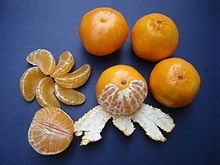- Clementine
-
Clementines Nutritional value per 100 g (3.5 oz) Energy 198 kJ (47 kcal) Carbohydrates 12.02 g - Sugars 9.18 g - Dietary fibre 1.7 g Fat 0.15 g Protein 0.85 g Water 86.58 g Thiamine (vit. B1) 0.086 mg (7%) Riboflavin (vit. B2) 0.030 mg (3%) Niacin (vit. B3) 0.636 mg (4%) Pantothenic acid (B5) 0.151 mg (3%) Vitamin B6 0.075 mg (6%) Folate (vit. B9) 24 μg (6%) Choline 14 mg (3%) Vitamin C 48.8 mg (59%) Vitamin E 0.20 mg (1%) Calcium 30 mg (3%) Iron 0.14 mg (1%) Magnesium 10 mg (3%) Manganese 0.023 mg (1%) Phosphorus 21 mg (3%) Potassium 177 mg (4%) Sodium 1 mg (0%) Zinc 0.06 mg (1%) Percentages are relative to US recommendations for adults.
Source: USDA Nutrient DatabaseA clementine is a variety of mandarin orange (Citrus reticulata), so named in 1902.[1] The exterior is a deep orange colour with a smooth, glossy appearance. Clementines can be separated into seven to fourteen segments. They tend to be very easy to peel, like a tangerine, but are almost always seedless. For this reason they are sometimes known as seedless tangerines. They are typically juicy and sweet, with less acid than oranges.[1] Their oils, like other citrus fruits, contain mostly limonene as well as myrcene, linalool, α-pinene and many complex aromatics.[2]
The traditional story of its origin is that it was "originally an accidental hybrid said to have been discovered by Father Clément Rodier in the garden of his orphanage in Misserghin, Algeria."[3] However, there are claims it originated in China much earlier. James Saunt has commented that "Some authorities believe it is virtually identical to the variety known as the Canton mandarin widely grown in Guangxi and Guangdong Provinces in China."[4]
The clementine is not always distinguished from other varieties of mandarin oranges.[citation needed] However, it should not be confused with similar fruit such as the satsuma or honey sweet orange, or other popular varieties. The clementine is occasionally referred to as Algerian tangerine[citation needed].
This variety was introduced into California commercial agriculture in 1914, though it was grown at the Citrus Research Center at the University of California, Riverside as early as 1909.[5] Clementines, usually grown in Morocco, Spain and south of Bosnia and Herzegovina, have been available in Europe for many years. A market for them in the United States was created recently, when the harsh 1997 winter in Florida devastated domestic orange production, increasing prices and decreasing availability. California clementines are available from mid-November through January; this availability has them referred to in some areas as "Christmas Oranges". Clementines are typically shipped in small wooden or cardboard boxes[6] with a move in recent years to net bags.[citation needed]
Clementines lose their desirable seedless characteristic when they are cross-pollinated with other fruit. To prevent this, in 2006 growers such as Paramount Citrus in California threatened to sue local beekeepers to keep bees away from their crops.[7]
References
- ^ a b Edible: An Illustrated Guide to the World's Food Plants. National Geographic. 2008. p. 73. ISBN 978-1426203725. http://books.google.com/books?id=HORIzBx17DYC&pg=PA73#v=onepage&q&f=false.
- ^ Ziegler, Herta (2007). Flavourings: production, composition, applications, regulations. Wiley, John & Sons, Incorporated. p. 203. ISBN 9783527314065. http://books.google.com/books?id=9J8USxfwkT0C&lpg=PA201&dq=clementines&pg=PA203#v=onepage.
- ^ Harper, Douglas (November 2001). "clementine". Online Etymology Dictionary. http://www.etymonline.com/index.php?term=clementine. Retrieved February 14, 2009.
- ^ Saunt, James (January 1, 2000). Citrus Varieties of the World (Second edition). Sinclair International Business Resources. ISBN 978-1872960012.
- ^ Hodgson, Richard Willard (1967). Chapter 4: Horticultural Varieties of Citrus. University of California, Division of Agricultural Sciences. http://lib.ucr.edu/agnic/webber/Vol1/Chapter4.html. Retrieved February 14, 2009.
- ^ Office of the Federal Register (U.S.), ed. Code of Federal Regulations, Title 7, Agriculture, Pt. 300-399. Animal and Plant Inspection Service, USDA Section 319.56-34. http://books.google.com/books?id=Z3yaSDjAGDsC&pg=PA383&dq=Clementines+boxes. Retrieved 17 July 2010.
- ^ "Calif. beekeepers fear no-fly zones". The Associated Press. KATU.com. December 2, 2006. http://www.katu.com/news/business/4842961.html. Retrieved July 17, 2010.
Citrus Important species Citron • Key lime • Persian lime • Mandarin orange • Pomelo
Important cultivars Bitter orange • Clementine • Grapefruit • Lemon • Lime • Orange • Rangpur • Tangelo • Tangerine • Naartjie
Other topics Categories:- Agriculture in California
- Citrus
- Hybrid Citrus
Wikimedia Foundation. 2010.

